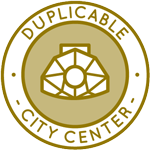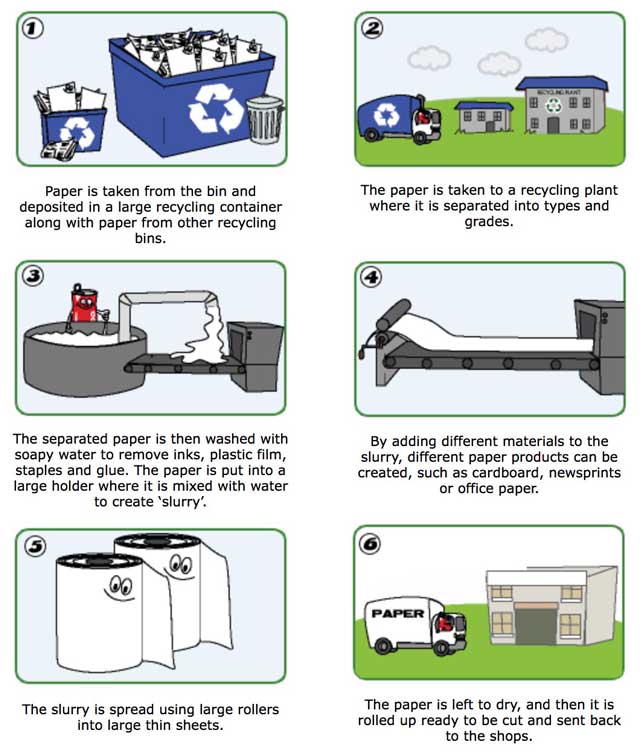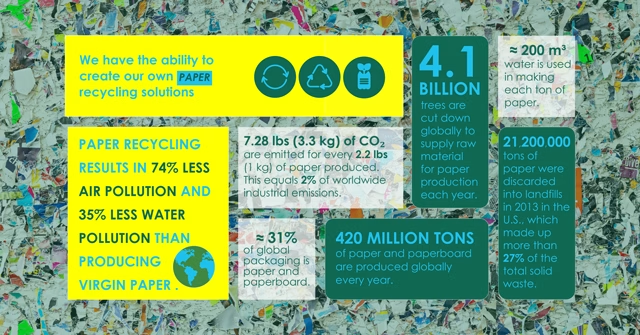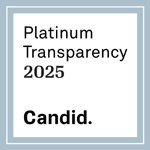
Best Small and Large-scale Community Paper Recycling, Reuse, and Repurposing Options
Paper is one of the easiest and most commonly recycled products. In addition to recycling, paper can also be sustainably and easily repurposed. We discuss small and large-scale approaches to both processes here and with the following sections:
- What is Paper Recycling, Reuse, and Repurposing
- Why Open Source Paper Recycling, Reuse, and Repurposing
- Ways to Contribute and Consultants
- Small and Large-scale Paper Recycling
- Resources
- Summary
- FAQ
RELATED PAGES (Click icons for complete pages)









WHAT IS PAPER RECYCLING,
REUSE, & REPURPOSING
 A simple definition for paper recycling is the reprocessing of used paper to form new paper1. In 2011, it was reported that over 66.8% of paper consumed in America was recycled2. In 2016 it was reported that over 72% of paper consumed in European countries was recycled, compared to 29.7% for plastics. The process is so easy that it can be done on a small scale in your own kitchen. Paper reuse and repurposing is even easier. Reuse and repurposing options include reusing waste paper for wrapping, packaging, composting, cleaning, lining pet cages, etc.
A simple definition for paper recycling is the reprocessing of used paper to form new paper1. In 2011, it was reported that over 66.8% of paper consumed in America was recycled2. In 2016 it was reported that over 72% of paper consumed in European countries was recycled, compared to 29.7% for plastics. The process is so easy that it can be done on a small scale in your own kitchen. Paper reuse and repurposing is even easier. Reuse and repurposing options include reusing waste paper for wrapping, packaging, composting, cleaning, lining pet cages, etc.
The ability to sell commercially recycled paper to foreign markets though has changed since 2011 and the value of this recycled paper has plummeted. Large and small-scale strategies for recycling, reuse, and repurposing of paper are still necessary though if we are interested in living sustainably, reducing our carbon footprint and combatting climate change, protecting trees and sensitive eco-systems, etc. We share here what One Community learned researching paper recycling and what we determined will be the best plan for 100% recycling of all our paper as part of self-sufficient and self-sustainable teacher/demonstration communities, villages, and cities for The Highest Good of All.
WHY OPEN SOURCE
PAPER RECYCLING, REUSE, & REPURPOSING
 One Community is working to create global sustainability and we see a consumer-driven effort to recycle more paper as helpful. We have researched the best small and large-scale recycling, repurposing, and reuse options for paper so we can implement these as part of the first or our sustainable village rollouts consisting of the Earthbag Village and Duplicable City Center. We’ll add to this page our own experience and anything else we learn as we build the 7 sustainable villages. We are open sourcing the process and our research to help others building teacher/demonstration hubs using our plans, those interested in possibly starting their own paper recycling business, and/or for those who would just like to better understand how paper recycling works and how they can positively contribute to the process.
One Community is working to create global sustainability and we see a consumer-driven effort to recycle more paper as helpful. We have researched the best small and large-scale recycling, repurposing, and reuse options for paper so we can implement these as part of the first or our sustainable village rollouts consisting of the Earthbag Village and Duplicable City Center. We’ll add to this page our own experience and anything else we learn as we build the 7 sustainable villages. We are open sourcing the process and our research to help others building teacher/demonstration hubs using our plans, those interested in possibly starting their own paper recycling business, and/or for those who would just like to better understand how paper recycling works and how they can positively contribute to the process.
WAYS TO CONTRIBUTE TO EVOLVING THIS SUSTAINABILITY COMPONENT WITH US
SUGGESTIONS | CONSULTING | MEMBERSHIP | OTHER OPTIONS
CLICK THESE ICONS TO JOIN US THROUGH SOCIAL MEDIA
RESEARCHERS FOR THIS COMPONENT:
Yomi Sanyaolu: Mechanical Engineering Graduate and Technical Writer
Angela Mao: Sustainability Researcher
SMALL AND LARGE-SCALE PAPER RECYCLING
Paper is one of the easiest and most commonly recycled products. Recycled paper already saves millions of trees, immense amounts of water, space in landfills, and all the fossil fuels and other resources that go into the process of making and disposing of paper. The more we recycle, the more we can save. We discuss both small and large-scale paper recycling here with the following sections:
- External/Commercial Paper Recycling Process
- Recycling Your Own Paper
- Cost, Labor, and Feasibility Comparison for All Community Paper Recycling Options
- Community Paper Recycling Business Options
- One Community’s Plan for Recycling Paper
EXTERNAL/COMMERCIAL PAPER RECYCLING PROCESS
Bulk recycling of paper is extremely important because the average household throws away 13,000 pieces of paper each year3. However, if all paper was recycled/reused, hundreds of millions of trees would be saved each year. Benefits of large-scale waste paper processing include4:
- Reducing greenhouse gas emissions that come from producing fresh paper
- Saving trees and saving space in landfills
- Cutting down on smog pollution from incineration
- Saving other resources, creating paper from the recycling process requires 70% less water and energy
HOW LARGE-SCALE PAPER RECYCLING WORKS
The graphic below shows how industrial-scale recycling works, from when you collect paper in your house to how it is processed5:

Source: http://www.recycling-guide.org.uk/science-paper.html
Here’s a video illustrating the process too:
BEING A GOOD RECYCLER – HOW YOU CAN HELP
To be a good paper recycler, don’t put non-recyclable paper in your recycling bin. These are the types of paper that cannot be recycled6:
- Paper with adhesives on it
- Shredded paper
- Coated/wax and treated paper
- Stained paper
- Baking/non-grease paper
- Wallpaper
- Paper cups and towels
- Juice and cereal boxes
- Laminated paper
Also work to reduce your own paper waste. Call to stop the delivery of magazines and junk mail you don’t want, use digital methods for notes and other things that might otherwise use paper, and reuse paper whenever you can. See below for ideas.
RECYCLING YOUR OWN PAPER
 Recycling your own paper can be achieved in many different ways which we will cover in this section. This is especially beneficial for those who do not have access to a local recycling collection service. Our hope is that the methods described will help reduce paper wastage that ends up in landfills. If you’d like some additional ideas, visit Vision Earth for “31 Ways to Reduce Paper Usage”7
Recycling your own paper can be achieved in many different ways which we will cover in this section. This is especially beneficial for those who do not have access to a local recycling collection service. Our hope is that the methods described will help reduce paper wastage that ends up in landfills. If you’d like some additional ideas, visit Vision Earth for “31 Ways to Reduce Paper Usage”7
Before recycling paper, consider first repurposing the paper for applications such as pet cage cushioning, packing material, wrapping paper, etc. Visit wisebread.com8 for a great list of other uses.
SUSTAINABLY REPURPOSING PAPER INTO COMPOST
For most people, adding shredded paper to compost is probably the easiest and best way to repurpose it. Benefits of this approach include9:
- Paper is a Source of Carbon: Shredded paper is an excellent source of Carbon, especially newsprint and financial-statement types of paper. Carbon is an essential component of a healthy compost system and adding shredded paper can help you attain the ideal Carbon to Nitrogen ratio of 25C:1N. A simple rule is, if your compost pile is smelly, you need more carbon.
- Moisture Retention: Adding shredded paper increases moisture retention which helps material break down faster and reduces odors and leakage issues. When used in soil, moisture can be recovered more at the root level and this promotes healthy growth.
- Increases Soil Volume: The volume of soil is increased with the addition of shredded paper. This means more fresh compost is available to use around your landscape.
- Worms: Shredded paper helps with vermicomposting because worms love paper and use it as a source of food and shelter in compost. Shred your paper if you’d like it to be easier for your worms to consume.
Keep in mind however that there are some papers that shouldn’t be recycled or composted. These include waxy papers, papers with foil or tape on them, and papers that have strong dyes, heavy inks, and other printing chemicals. Also don’t compost coffee cups, take-out boxes, milk or juice cartons and paper plates because they often contain plastic. Only compost them if they are certified compostable.
SUSTAINABLY REPURPOSING PAPER INTO PAPERCRETE
Papercrete is an inexpensive construction material made of paper, sand, and Portland Cement. Different types of papercrete can be formed depending on the ratio of the ingredients. Some of the benefits of papercrete are10:
- It is a good heat and sound insulator
- It is lightweight while still providing excellent compressive strength
- It is easy to make and uses inexpensive and readily available ingredients
Unfortunately, there are also some weaknesses that should be considered when using papercrete as a building material. These are primarily durability and susceptibility to moisture and termites10.
Here’s a video showing how to make papercrete.
Here’s an outline of the ingredients and process11:
Ingredients:
- 5-gallon buckets and a colander for draining the paper pulp
- A heavy-duty drill that will accommodate a half-inch bit
- Plaster or paint mixer attachment or a stucco mixing blade attachment
- Enough water to cover the torn paper by two inches
- Portland Cement
- Vermiculite, perlite, sand, or dirt. (Vermiculite and perlite are light fillers while sand and dirt are heavier and sturdier fillers.)
- Wood, nails, and hammer to build forms – If forming bricks, an actual brick will help to determine the size of the form
Process:
- Tear the paper into long, 2-inch strips and drop into the 5-gallon bucket until almost full
- Soak the paper strips in the bucket using water
- Tamp the paper down with the paint mixer to compress it slightly so it is beneath the water level by at least two inches
- Let the paper soak for 24 to 48 hours. You could also boil the paper in a large stock-pot for 30 minutes if you’re in a hurry
- Attach the paint or stucco mixer to the drill and move it around in the paper to shred the paper to a pulp
- Experiment with drill speeds to determine which speed does the best job based on the power of your drill
- Continue to pulp the paper pulling up the mixer from the bottom and sides. If the mix is too dry and resists pulping, add water. If the mix is too wet, drain off some water from the top or add more paper (You can add small proportions of dried paper if necessary, but tear it into small pieces)
- The final pulp should have the consistency of cottage cheese or lumpy oatmeal
- Once pulped, you can add a quart of bleach if you want to diminish the grey color. Pour in the bleach and continue to pulp and distribute the bleach with the mixer until blended. As the paper pulp soaks, the color will bleach to a light greyish-white
- Strain the pulp through a colander or, for larger batches, improvise a strainer with a screen supported by chicken wire on a wood frame
- Reserve the pulp for the final formula
- Add the proper proportion of paper pulp to the mixing container (the video suggests using 5 parts paper pulp in a 5-gallon bucket)
- Add the proper proportion of cement next (For this example, the video is using 2 parts cement)
- Begin blending the mixture using the trowel. If it gets too dry, add some more paper pulp. If it’s too wet, add more cement
- When done, it should have the consistency of chunky pudding
- It should not settle when placed on a board, but hold its shape. If so, you’re now ready to trowel it into a form. If you are applying it to the side of a mold for a pot or other object, you’ll want to have a thicker consistency so the wet papercrete will not slide down the mold
- Cover the mold or form with plastic wrap for 24 hours to let the papercrete slowly cure, then remove the plastic wrap and remove the form to allow the papercrete to stand freely for further drying
- Let dry for another 2 days
- If drying outdoors, cover it with a loose-fitting tarp to prevent morning dew or rain from coming in contact with it. If making papercrete in winter, you’ll need to let it dry in a relatively warm area like a garage or a place where you have improvised some form of heat
- Something as simple as covering it with a black tarp or a black plastic garbage bag could capture enough heat from the sun to do the job during a cold day
SUSTAINABLY REPURPOSING PAPER INTO CELLULOSE INSULATION
Cellulose insulation is an eco-friendly and cheap insulation made by mixing shredded paper (mainly newspaper) with boric acid12. It is typically blown into attic and/or wall spaces. The boric acid makes the insulation fire, mold, and insect resistant.
Here’s a video showing how cellulose insulation is made commercially:
Here is a DIY tutorial on preparing cellulose insulation using shredded recycled paper by ehow.com: “How to Make Shredded Paper Cellulose”13
Equipment:
- Recycled paper (preferably newspaper)
- Paper shredder
- Large plastic zipper bag
- Boric acid paste
Process:
- Separate any glossy or colored sheets of paper from the batch as they cannot be used
- Shred your recycled paper until there is sufficient amounts for the insulating needs
- Place the shredded paper in the plastic bag and add a few drops of the boric acid paste
- Tightly close the plastic bag with a zipper seal and knead the paste into the shredded paper
- Allow the cellulose to dry completely before use
WARNING: Do not breathe in boric powder or cellulose fibers because they can damage your lungs
DIY RECYCLING OF PAPER INTO NEW PAPER
Paper can also be recycled into new paper. Here is a DIY process from cleanipedia14 for recycling paper to make your own paper. Buying all the equipment new would cost around $120 USD, but most people already own the items needed. One exception would be a shredder, but the paper can also be shredded by hand before being added to the blender. A really high-powered blender (like a BlendTec or Vitamix) can also blend and shred. This leaves only the cost of the mesh and picture frame without the glass, both of which can be purchased for less than $10 USD.
Most types of paper are usable for this paper making process, except for:
- Used paper towels
- Paper that is stained with food dirt or paint
- Greaseproof or baking paper
- Wallpaper
- Paper with gum on it like stickers etc.
Here is a video of the process:
Equipment:
- Picture frame without the glass
- Mesh larger than the picture frame
- Kitchen bowl larger than the picture frame
- Sponge
- Towel
- Blender
- Shredder or shred by hand or use a high-powered blender like a BlendTec or Vitamix
Process:
- Creating the screen: Tape or staple the mesh to the picture frame
- Mixture: Shred the paper you are recycling and blend it with warm water in the bowl
- Once you have a smooth pulp, submerge the picture frame into the mixture
- Pull the frame back out and rest it on an old towel. The mesh should be full of the paper pulp from your washing-up bowl
- Add any decorations, such as dried flowers, or scraps of colored paper that you like and cover with a little more pulp from your bowl
- Press the sponge across the frame to squeeze excess water from the pulp
- Leave the frame to dry for at least a day, and then peel off your new sheet of paper
DIY PAPER RECYCLING MACHINERY
Machinery also exists for large-scale recycling of paper into other products. We discuss here the two non-commercial options we found.
PAPER RECYCLING INTO TISSUE PAPER
 Large-scale paper creation can also be accomplished using machinery. The machine pictured at right is from Alibaba and transforms used paper into tissue paper. The tissue produced can be used or sold, so this is a potential business opportunity for small organizations/communities that produce a lot of waste paper. Starting price for this product is $5k USD and it can go to as high as $25k USD.
Large-scale paper creation can also be accomplished using machinery. The machine pictured at right is from Alibaba and transforms used paper into tissue paper. The tissue produced can be used or sold, so this is a potential business opportunity for small organizations/communities that produce a lot of waste paper. Starting price for this product is $5k USD and it can go to as high as $25k USD.
PAPER RECYCLING INTO CELLULOSE INSULATION
 Machines can be purchased for recycling paper into cellulose fiber for insulation too. This is much easier than following a DIY tutorial. The machine pictured at right can be purchased for $5k to $20k USD from Alibaba. Paper fed into the machine is crushed and transformed into cellulose fiber for insulation. Makers of the machines say they are high efficiency, low energy consumption, and produce minimal noise.
Machines can be purchased for recycling paper into cellulose fiber for insulation too. This is much easier than following a DIY tutorial. The machine pictured at right can be purchased for $5k to $20k USD from Alibaba. Paper fed into the machine is crushed and transformed into cellulose fiber for insulation. Makers of the machines say they are high efficiency, low energy consumption, and produce minimal noise.
COST, LABOR, AND FEASIBILITY COMPARISON FOR ALL OPTIONS
After completing the research above, we compared the 5 different options for processing used paper. The factors we assessed were: End-product Uses, Business Potential, Cost, Labor, Safety, and Sustainability. The DIY recycling into new paper has been omitted from the comparison due to the process being ineffective at processing the large amounts of paper that will be generated at a sufficient rate.

Paper Recycling Options Comparison
COMMUNITY PAPER RECYCLING
BUSINESS OPTIONS
 The easiest community paper recycling business option is to collect paper and to sell it to your local recycling center. That recycling center then sells the paper to companies that use it to make new products. The most common examples of products made from recycled paper are white printing paper, toilet paper and tissues, paper towels and napkins, greeting cards, cardboard, and magazine and newspapers
The easiest community paper recycling business option is to collect paper and to sell it to your local recycling center. That recycling center then sells the paper to companies that use it to make new products. The most common examples of products made from recycled paper are white printing paper, toilet paper and tissues, paper towels and napkins, greeting cards, cardboard, and magazine and newspapers
There is a lot of potential to make good money with a business like this. Part timers can make $300 in a weekend, and some full time business owners make over $100,000 annually. Here are the steps needed for setting up this kind of business:
- Plan your business first. Make sure you understand the costs in operating a paper recycling business. Check the current rate being paid in your area for recycled paper and evaluate your options and costs for collection, processing, and delivery. Typically, you’ll need at a minimum a vehicle for transporting paper, a scale for weighing paper, a covered and dry area for storing paper, a utility knife for breaking down boxes, and a small office or desk area for keeping cash and managing books. Even if you do not have a lot of capital to begin with, you can use your personal vehicle for transportation. You can also use a storage shed or your garage to keep paper.
- For ongoing expenses, you only really have to be concerned about fuel costs and any facility costs (if you are renting one).
- You will then need to find sources to collect paper. Consider small offices, print shops, and retailers since they are located close to each other, so the distance between pickup locations is reduced. Additionally, their paper will not be contaminated with food, which can make it difficult to recycle properly.
- Check your rates! Recycling business owners make a profit from the paper that they bring to recycling facilities. The rates paid are usually given per ton; for instance, a newspaper might go for $50 per ton. Make sure you check the rate your local recycling facility offers, as they are the ones who will be paying you.
- Tip: Do not charge the people and organizations you collect paper from. Charging to take paper away frequently results in a business taking away garbage as well as recyclable paper. Not charging to take away paper makes it easier for a business to require that people and organizations properly sort recyclable paper from unwanted garbage.
- Another way to make your business even more profitable is to offer secure shredding services, as many businesses will actually pay to have documents shredded.
For more detailed information, check out the article this information was sourced from:
Article: How To Start a Paper Recycling Business
ALTERNATIVE BUSINESS OPTION: RECYCLED PAPER PRODUCTS
An alternative approach to a paper recycling business is to collect the paper and create a product from it that you can sell to make a profit. If you live in a small community, you can offer to collect their recyclable paper from them and use it in your products. It is also a great way to recycle your own paper.
By treating the paper pulp, you can recycle it into paper for your own use and for creation of new products. Some potential products you can manufacture at home are paper plates, paper envelopes, paper pockets, and many more. With a little creativity, you can turn an old paper bag into a cute holiday gift bag. You can also turn paper bags into actual gift wrap by turning them inside out or turn them into gift tags! You can also create your own paper (see above) and sell it as an arts and crafts option for others.
Creative retailers are also selling other items that have not traditionally been made from recycled paper. For instance, Ten Thousand Villages sell flower vases, picture frames, clocks, and other crafts made from recycled paper. Here are a couple Etsy retailers who sell recycled paper products they made themselves too.


If you want a comprehensive list of potential recycled paper products, check out these articles:
- Article: “Get Crafty: 8 Cool Paper Projects to Make and Sell Online”
- Article: “6 Interesting Products That Can Be Made from Recycled Paper Products”
- Article: “Surprising & Innovative Items Made from Recycled Paper”
ONE COMMUNITY’S PLAN FOR RECYCLING PAPER
 Moving forward, One Community will be composting all our cardboard and compostable paper waste. If sufficient paper is generated to warrant it, we will invest in an industrial shredder to further aid the composting process. Our reasons for choosing this waste processing methodology are:
Moving forward, One Community will be composting all our cardboard and compostable paper waste. If sufficient paper is generated to warrant it, we will invest in an industrial shredder to further aid the composting process. Our reasons for choosing this waste processing methodology are:
- It is a free, low labor and safe process
- It is eco-friendly and required no power
- Can address large quantities of paper easily and efficiently
- Easy to do and doesn’t require separating soiled and non-soiled paper
- Compost produced can be used for Highest Good food Component
If we end up with enough paper to justify purchasing an industrial shredder, any paper not used for compost can be used to produce cellulose insulation for the various Highest Good Housing projects One Community is undertaking. One Community will open source here our complete process as we grow our community to 1000+ residents and host over 100,000 overnight visitations annually. Our goal in doing this is to provide an open source example for other communities/organizations that want to take recycling/processing paper into their own hands, especially in situations where local recycling services aren’t available.
RESOURCES
Here are the numbered resources referenced above:
- Article: “Paper Recycling – Waste Paper Recycling & Collections”
- Article: “Everything You Need to Know About Paper Recycling”
- Article: “Paper Recycling Facts”
- Article: “How Does Recycling Paper Help the Environment”
- Article: “How Paper is Recycled”
- Article: “How to Recycle Paper the Right Way”
- Article: “31 Ways to Reduce Paper Usage”
- Article: “22 Ways to Reuse Paper”
- Article: “Can You Compost Shredded Paper”
- Article: “What is Papercrete – Its Properties, Uses and Benefits in Construction”
- Article: “How to Make Papercrete”
- Article: “Cellulose Insulation – A Smart Choice”
- Article: “How to Make Shredded Paper Cellulose”
- Article: “How To Recycle Paper At Home”
Here are other resources we’ve found useful:
- Article: How To Start a Paper Recycling Business
- Article: “Get Crafty: 8 Cool Paper Projects to Make and Sell Online”
- Article: “6 Interesting Products That Can Be Made from Recycled Paper Products”
- Article: “Surprising & Innovative Items Made from Recycled Paper”
- Use this page (click here) if you have a resource you’d like to suggest be added here
SUMMARY
 One Community has invested extensive time and research into the best small and large-scale recycling, repurposing, and reuse options for paper (and plastic, glass, polystyrene/styrofoam, clothing, food and other perishable items, and even non-recyclables). Composting looks to be the easiest, safest, and most sustainable option. We will open source share here our group’s experience with composting 100% of our paper as part of the development of the Earthbag Village and Duplicable City Center. We will evolve this page with videos and other data from this process as we use what we learn to help us improve our recycling, repurposing, and reuse strategies as we build each of the next 6 sustainable village models and grow to a community of hundreds.
One Community has invested extensive time and research into the best small and large-scale recycling, repurposing, and reuse options for paper (and plastic, glass, polystyrene/styrofoam, clothing, food and other perishable items, and even non-recyclables). Composting looks to be the easiest, safest, and most sustainable option. We will open source share here our group’s experience with composting 100% of our paper as part of the development of the Earthbag Village and Duplicable City Center. We will evolve this page with videos and other data from this process as we use what we learn to help us improve our recycling, repurposing, and reuse strategies as we build each of the next 6 sustainable village models and grow to a community of hundreds.
FREQUENTLY ANSWERED QUESTIONS
Q: In the US, how much recovered paper stayed in the US?
In 2011, 42 percent of recovered paper was exported to overseas markets. About 53 percent stayed in the US to be recycled into paper and paperboard products. The remaining 5% was used to make other non-paper products. (source)
Q: What would you recommend for an individual interested in recycling all their paper waste?
First and foremost, reduce how much paper waste you produce by canceling junk mail and magazines you don’t need. Then compost your paper if you can. Composting is by far the easiest, most affordable, and most useful approach to repurposing paper waste.
Q: Can a piece of paper be recycled indefinitely?
No, each time paper is recycled, the fibers get shorter. After being recycled multiple times (5-7), the fibers become so short they can no longer bond to create new paper. To address this, new fibers are added to replace the unusable fibers that wash out of the pulp during the recycling process.
Q: What products can be made from recycled paper?
Besides easily recognizable paper products (e.g, writing paper or paper towels), more than 5,000 products can be made from recycled paper, including:
- Masking tape
- Paper money
- Globes
- Bandages
- Dust masks
- Hospital gowns
- Coffee filters
- Lamp shades
- Car insulation
- Animal bedding
- Planting pots for seedlings
- Egg cartons
Q: Who invented paper and when?
Ts’ai Lun in 105 AD.
 One Community
One Community



